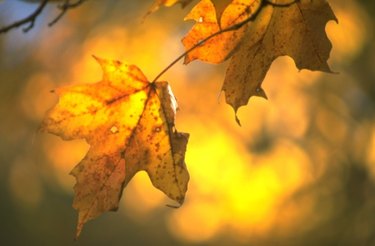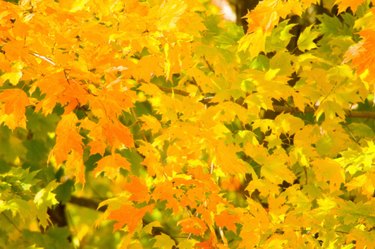
Finding the leaves of one or more of the ornamental maple trees in the home landscape turning yellow can be disheartening. There are several causes for this, and figuring out just what is wrong quickly may mean the difference between life and death for the tree. It may be a simple fix and it may not even be anything to be concerned about, but finding out quickly is crucial.
Maple Tree Decline
Video of the Day

Maple tree decline is a progressive condition that typically signals the end of the tree's lifespan. One of the early signs of the condition is premature yellowing of the leaves, which can occur well before the leaves should normally turn for the fall months, typically in July or August. There are other signs that accompany maple tree decline, including an early defoliation, death of small twigs and branches, brittle roots and a lack of leaves across the upper branches of the tree.
Video of the Day
This is a progressive disease that has a number of causes from insect infestation to a lack of nutrients. If caught soon enough, the tree can sometimes be saved. It is not a contagious disease, and nearby trees often show no ill effects.
Chlorosis

Chlorosis is a condition that makes leaves turn prematurely yellow. The way in which the leaves are turning can help to indicate whether the problem is chlorosis. The change is gradual, with the area between the leaf veins turning first. The veins of the leaves themselves remain bright green. In severe cases, entire leaves can turn yellow and develop brown spots along the veins. All or some of the tree may be infected, and the yellowing may only occur in a single branch.
The condition is not the result of any kind of infection but the death of the chlorophyll that makes the leaf green is caused by an imbalance in nutrients such as iron, manganese or boron.
Leaf Scorch
Bacterial leaf scorch occurs when a bacteria infects a tree, typically one that has already been weakened by unfavorable environmental conditions such as drought. The bacteria can infect a variety of trees and cause a distinctive pattern of scorching on each type. The leaves of maple trees will exhibit yellow bands that travel down the leaf; the central part of the leaf remains green the longest, with the edges turning brown and dying as the leaf scorch kills the tree.
The bacteria is carried by insects that move from tree to tree, so the condition can spread throughout a group of maples and infect other trees, especially the vulnerable elm and oak.
Carotenoids

Carotenoids are pigments that are always present in the leaves of some maple trees but are hidden by the more numerous chlorophyll during the growing season. Chlorophyll, the pigment that makes the leaves green and is required for photosynthesis, begins to die as the days get shorter and colder. When this process begins, it reveals the other pigments in the leaves.
Depending on the weather, this change can happen as early as late summer. Sunny days followed by cool nights can speed up the process and cause leaves to turn yellow earlier than expected. Warm, wet summers can also impact the development of the yellow pigments in leaves, making them stronger and able to show sooner.